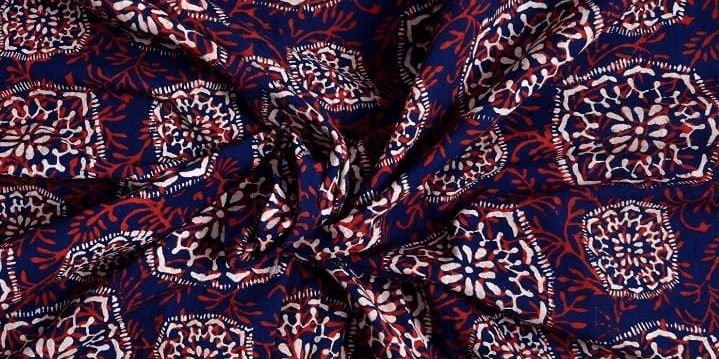CREATING INNOVATIVE PRODUCTS FROM TRADITIONAL BAGRU TO ENCOURAGE ITS USE IN MODERN ERA
Abstract
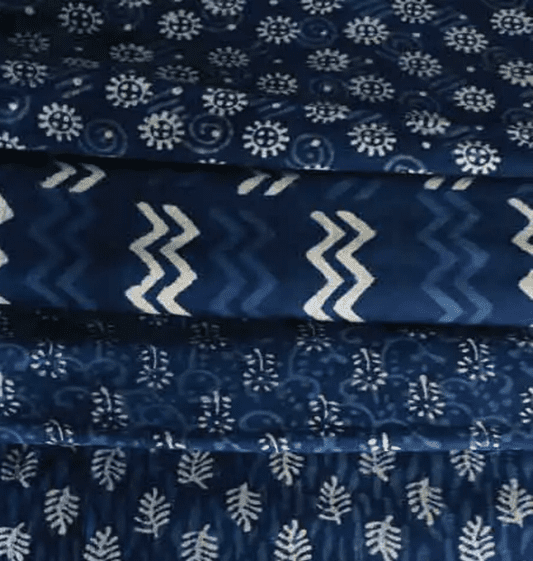 The reduction in demand for these textiles has also resulted in a decrease in jobs, earnings, and prospects for these artisans. As global fashion impacts Indian clothing culture, we may now use traditional fabrics to create trendy outfits and accessories.
The reduction in demand for these textiles has also resulted in a decrease in jobs, earnings, and prospects for these artisans. As global fashion impacts Indian clothing culture, we may now use traditional fabrics to create trendy outfits and accessories.
This study investigates numerous fashion accessories made of traditional Bagru that may be styled with western clothes. Even though Bagru technique faces challenges due to the threat of globalization, this unusual art of creation must be supported in the current context of fast fashion. Bagru printing is one of the ancient natural color printing methods practiced by the chippas of a distant region of Rajasthan. The procedure begins with the preparation of the material and ends with completed printed fabrics using indigenous methods. Motifs with a specialty are transferred onto a light-colored background using wooden blocks in two styles – direct and resist.
Introduction
India has always been a forerunner in terms of ancient traditions and crafts. We still have some of our cherished possessions thanks to the efforts of various groups and areas in India. One of them is Bagru prints, a hand block printing method that uses traditional vegetable dyes to print and color clothing. Blue, for example, is created from indigo, whereas greens are made from indigo mixed with pomegranate, red from madder root and yellow from turmeric.
What is Bagru
Bagru, a beautiful kind of block printing that originated in Rajasthan, reflects the beauty of handcrafted Indian textiles combined with modern design. Bagru, one of India’s oldest block printing methods, originated in a small town near Jaipur called Bagru, a centuries-old hub for hand block printed textiles.
textiles combined with modern design. Bagru, one of India’s oldest block printing methods, originated in a small town near Jaipur called Bagru, a centuries-old hub for hand block printed textiles.
Bagru block printing is a traditional Rajasthani craft that has been done for centuries. The technique is over a century old, and it was developed by families and passed down through generations. The craft boasts master craftsmen who have been dedicated to it for a long time, and it is a tediously long process that involves creating wash-resistant prints.
There is no written history of this printing method, although it is believed that it began approximately 450 years ago in Bagru, a tiny town near Jaipur, Rajasthan, which is famed for its exquisite workmanship. This town is home to the CHHIPAS community, a group of traditional craftspeople who print and create textiles by hand. They are well-known for their one-of-a-kind designs of lush trellis in sophisticated colours.

Bagru printing is a handcrafted method that produces some of the most exquisite bed coverings, kurtis, ghagras, and other fabrics. They continuously block impression prints. The major beauty of this work is the slightly varied positioning of the same block.
History of Bagru
 The Sanganeri printing art form was brought to Bagru by a group of Chhipas 450 years ago. Even now, their community works together in Chhippa, a town along the Sanjaria River. The quantity of water in the overflowing ‘Sanja’ river and its clean, sunlit riverbed aided their settlement. Even though the river has dried up, these artisans continue to thrive in Bagru, employing the same techniques as before. This is due to the loyal patronage of the locals. The name ‘Bagru’ refers to a group of craftsmen who deal with clay from the banks of the Tungurah River. The clay is used to generate the foundation color of the well-known baguette patterns. They then stamp beautiful designs on the fabric using natural dyes in earthy colours.
The Sanganeri printing art form was brought to Bagru by a group of Chhipas 450 years ago. Even now, their community works together in Chhippa, a town along the Sanjaria River. The quantity of water in the overflowing ‘Sanja’ river and its clean, sunlit riverbed aided their settlement. Even though the river has dried up, these artisans continue to thrive in Bagru, employing the same techniques as before. This is due to the loyal patronage of the locals. The name ‘Bagru’ refers to a group of craftsmen who deal with clay from the banks of the Tungurah River. The clay is used to generate the foundation color of the well-known baguette patterns. They then stamp beautiful designs on the fabric using natural dyes in earthy colours.
The name ‘Bagru’ refers to a group of craftsmen who deal with clay from the banks of the Tungurah River. The clay is used to generate the foundation color of the well-known baguette patterns. They then stamp beautiful designs on the fabric using natural dyes in earthy colours.
How is Bagru Made?
The procedure of making Bagru print is simple, and it appears to be like the practice and technique of printing with natural dyes or components, which includes the following steps: Preparation of unprocessed cloth, making dyes and natural colours, as well as developing complex dyeing processes for resist printing. The Chippa community in South Africa has launched a new effort to recycle or charge wasted water inside the earth. The “Harda” is a method of removing pollutants like as oil and dust from textiles by washing, drying, then drying them again. It takes two days to make a paste out of soda ash, sesame oil, and cow manure, and then wash the fabric with it.
Direct dye printing and resist printing are the two major forms of printing employed in Bagru. The blocks are soaked in refined oil or mustard oil overnight and then cleaned in both methods. For this printing, wooden tables are commonly utilized, with the size of the cloth varying depending on the length of the to be printed.
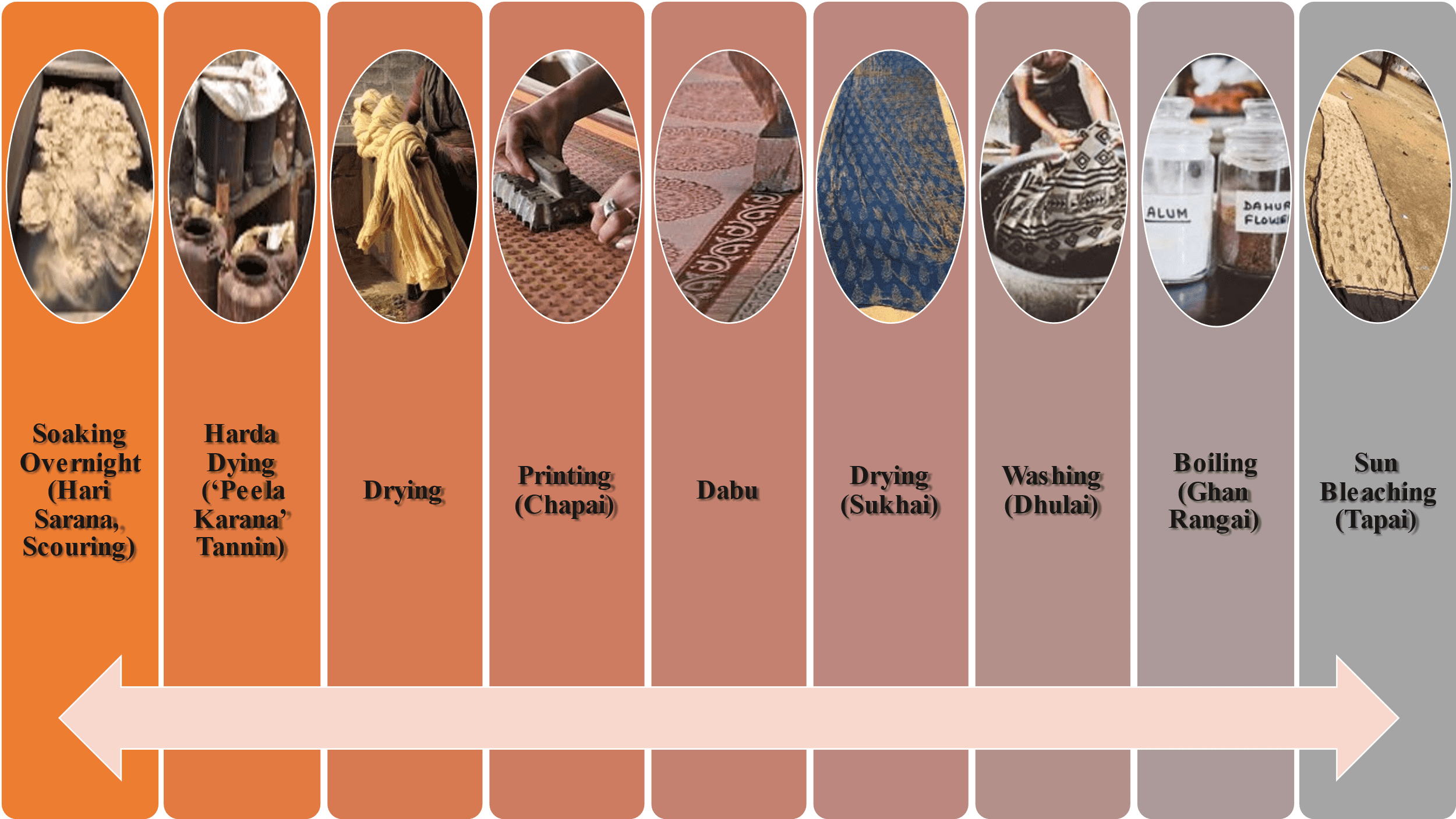
- Direct dye printing
The dye solutions are put into the tray in the first phase, and the printer pushes the block into the dye tray. For the backdrop, the outline pattern is done in blocks, with accents in various hues. The cloth is ready for the dye vat once each of the designs has been completed. Male printers are mostly responsible for this type of printing.
- Resist printing
The “DABU” printing process is a sort of resist style that is most recognized for its intricate pattern. They start with a specially made “Dabu” paste, then add a thick black mud paste to the cloth before dying it. To make a unique Dabu paste, each family has its own method.
Dabu preparation
Dabu is produced from a mixture of lime mixed in water, natural gum ‘Bedhan’ or worm-infested wheat flour, and black clay. All of this is mixed into a thick paste and set aside overnight. After that, it’s squeezed into a liquid paste for printing. The tablecloth is spread out and blocks are chosen to print patterns on it.
Depending on the sort of dye required, there are three varieties of Dabu: kaligar, gawar, and dolidar. Kaligars contain a bit more gum, which gives them superior adhesive strength and allows them to make two journeys to the dye vats. Oil and gawar seed powder are added to the paste in Gawarbali Dabs, giving it the power to withstand repeated dyeing. Dolidar Dabs are oil-free and gawar-free, allowing them to be used for extended periods of time.
Vegetable colours used in Bagru printing
Red, black, yellow, and blue are the colours used in Bagru printing. Dried pomegranate rinds, turmeric, and dried flowers from Dhabaria plants are used to make yellow. The color black comes from fermented Harda seeds, blue comes from the indigo plant, and the color red comes from the Aahl tree’s Madder.
Indigo is a difficult dye to work with since it is water insoluble. Natural indigo is cooked in Pawar seeds and left overnight to make it soluble. The next day, this solution, together with lime, is dissolved in 15-foot-deep vats and left undisturbed for a day. After then, the dyeing process begins. More dipping in the water results in a darker blue color, and a cloth may be dipped a maximum of six times.
Creating Fashion Accessories from Bagru
Bagru is traditionally used for making kurtis. Sarees, dupattas, dress materials, bed covers, and pillow covers. Due to the influence of western culture and fast fashion people are slowly moving towards the synthetics and digital prints. This current trend in the textile industry not only affects the demand and supply of natural materials, but it also has a negative impact on the traditional craftsmen of India, who not only follow this job as a profession, but also pass it down through generations. Western influence has posed a danger not just to traditional textiles and crafts, but also to the ecology since we are increasing the synthetic textile and chemical waste.
Bagru was used to make fashion accessories that may be worn with Indian or Indo-Western clothing to complete the look. These products were created with the intention of encouraging the usage of such textiles in fashion, if not as an entire outfit, then as a fashion accessory.
If these products are commercialized, they will not only encourage sustainable, natural and eco-friendly fashion, but would also provide and employment to our artisans.
A study was conducted to understand what women of various fields thought about using such products and how many of them were aware if these products could be made from such Indian fabrics. Women surveyed were between 20 to 50 years of age, majority of them were between 21-25 years. They were from various professional backgrounds. Only 71.2% people knew what Bagru is. A whooping number of 76.9% women said that they would prefer using accessories made from fabric instead of the metal or plastic accessories. 15.4% women were unsure if they would prefer these accessories or not and 7.7% said that they would not prefer fabric accessories over metal or plastic accessories. 59.6% women were unsure if synthetic textiles negatively impacted the environment and 23.1% agreed that synthetic textiles negatively impacted the environment. 76.9% agreed that increasing trend of synthetic textiles is affecting the traditional Indian artisans.
Following products were developed with Bagru:
- Neckpieces: Neckpieces are an important accessory for an Indian woman. These are manufactured in tons with a lot of mental and plastic that not only harm the environment but also cause skin issues. Fabric neckpieces are a very good option as an accessory that can be easily paired with all kinds of fabrics and look trendy too. Bagru fabric enhances this look with its intricate design and earthen colors.
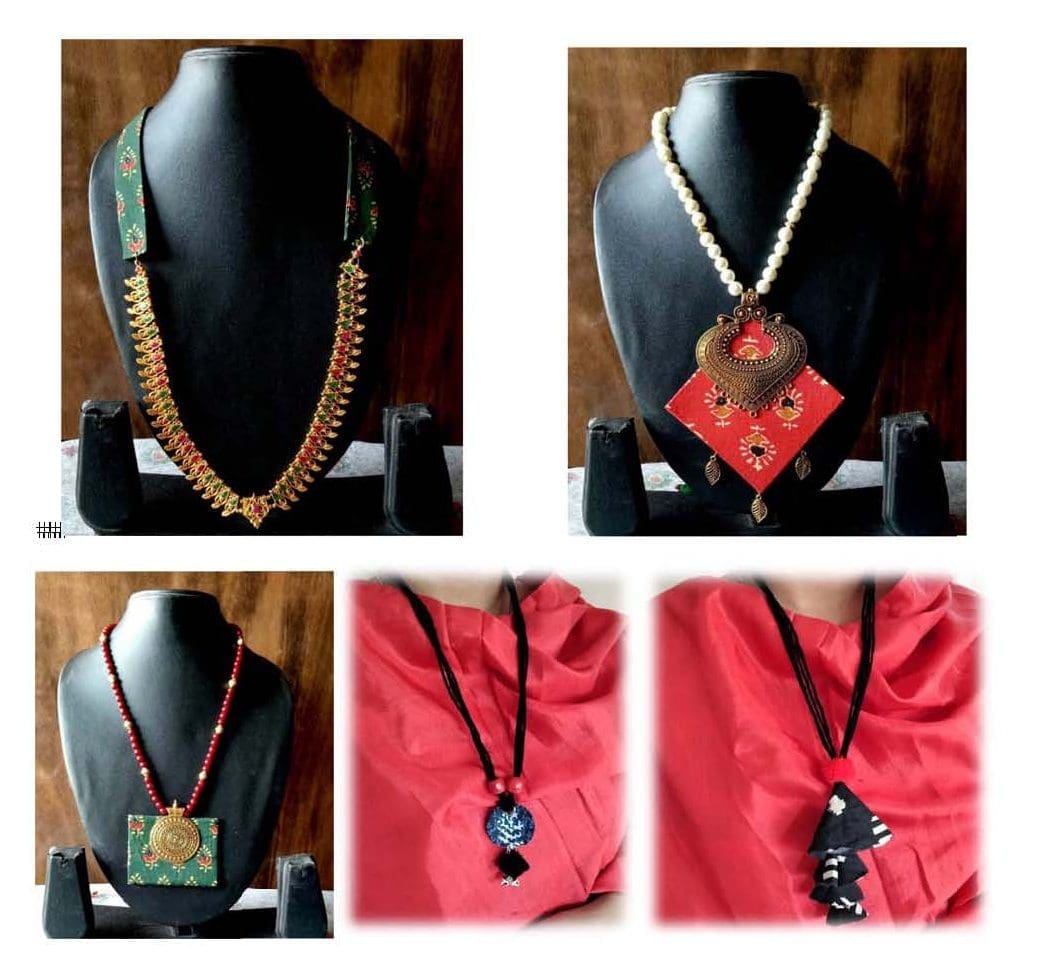
- Earrings: Fabric earrings are a good alternative to metal earrings. Bagru earrings can be easily paired with India, western and indo-western attires.

- Hairbands: Hairbands generate a lot of plastic and metal waste. Fabric hairbands, especially knotted ones are gaining a lot of popularity since last couple of years. Bagru hairbands were made to suit all kinds of outfits.
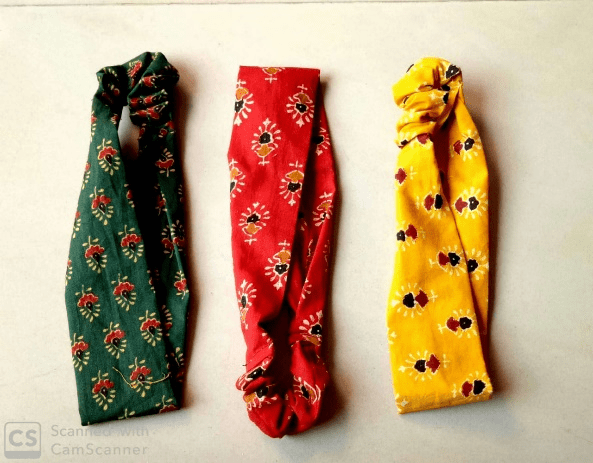
- Sling Bags: Bag industry utilizes a lot of leather, synthetic textile materials, metals and rexin every year. This not only affects the environment but is also a major reason for animal slaughtering on large scale. Fabric bags are an eco-friendly option that can be made in classy varieties.
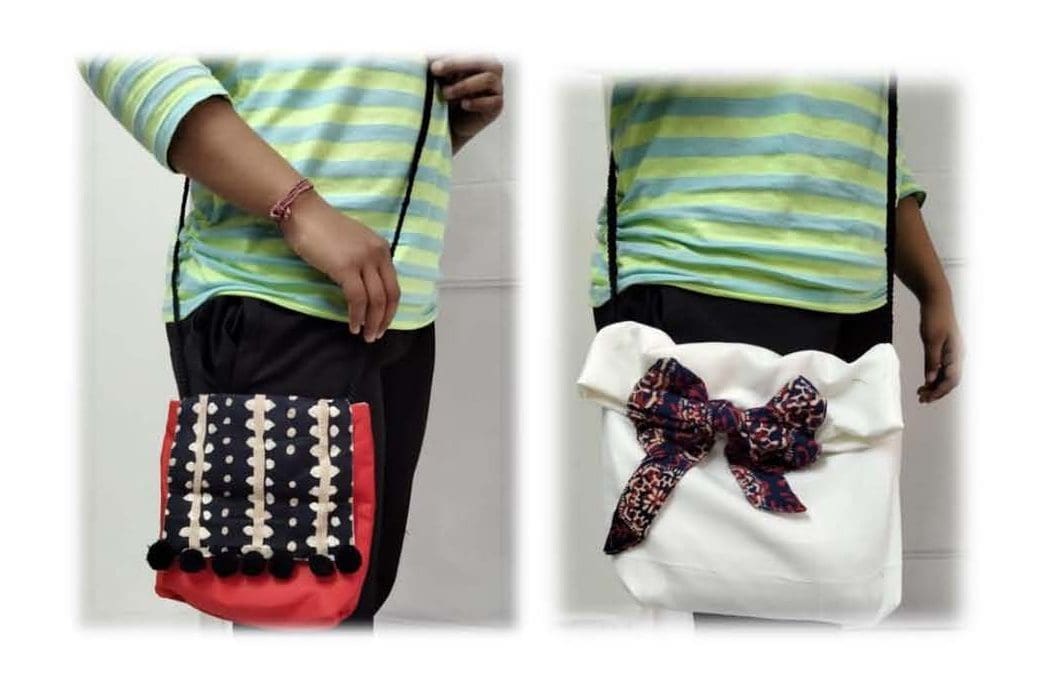
- Waistbelts: Waistbelts are often made with metal and leather to enhance the look of a dress or wearer’s figure. Bagru prints and earthen colors not only enhance the look of a plain dress but also are a great option for all kinds of outfits.

- Pad Holders: Carrying a sanitary napkin is always an embarrassing task for women, this is the reason why most of them prefer to hide it in a plastic bag or a news paper or any other covering. Pad holders serve this purpose in a very innovative way. They can be used regularly and they serve the purpose in a very sophisticated manner.

- Ready to use Patches: Patches for denim jackets and pants have gained a huge popularity among youngsters. The ready to wear patches made can be used easily by just ironing them over a garment or a bag that need an embellishment or a patch to hide any sort of damage. These patches are made in various shapes and sizes and can be used for any kind of clothing.
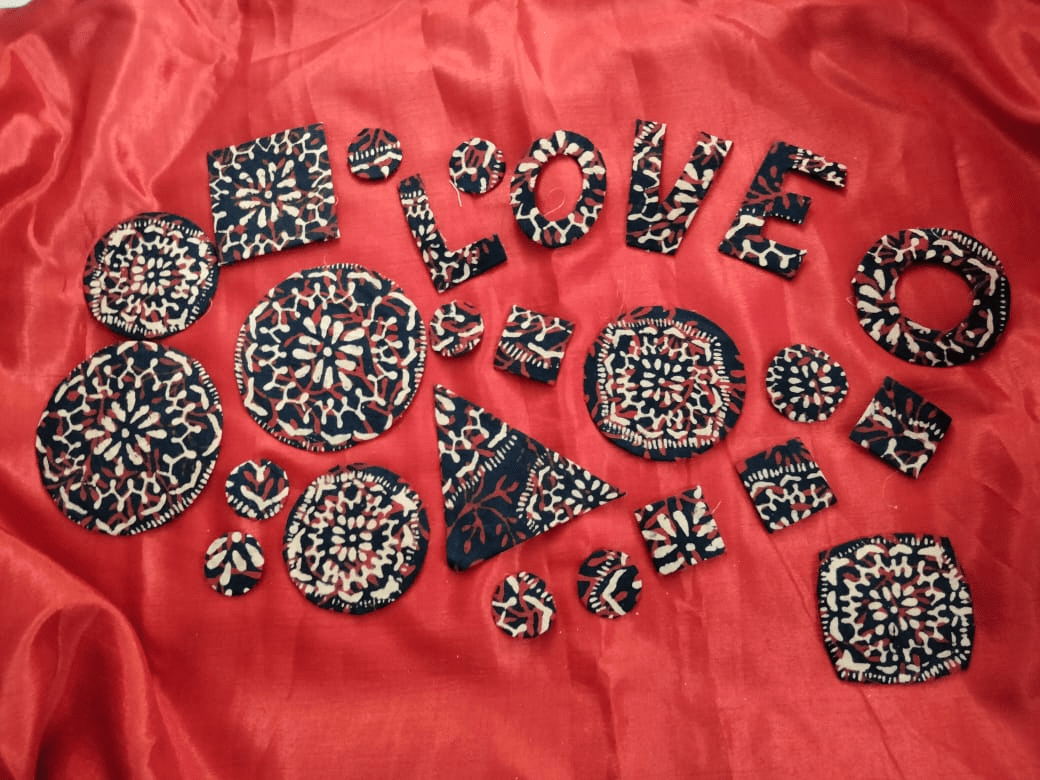
- Scrunchies: Hair scrunchies are the modern name for a hair tie. This accessory gathers all your hair strands and wraps them up and you look the most stylish diva of all times. Unlike traditional hair bands, hair scrunchies don’t detangle your hair while taking them out from your hairs.
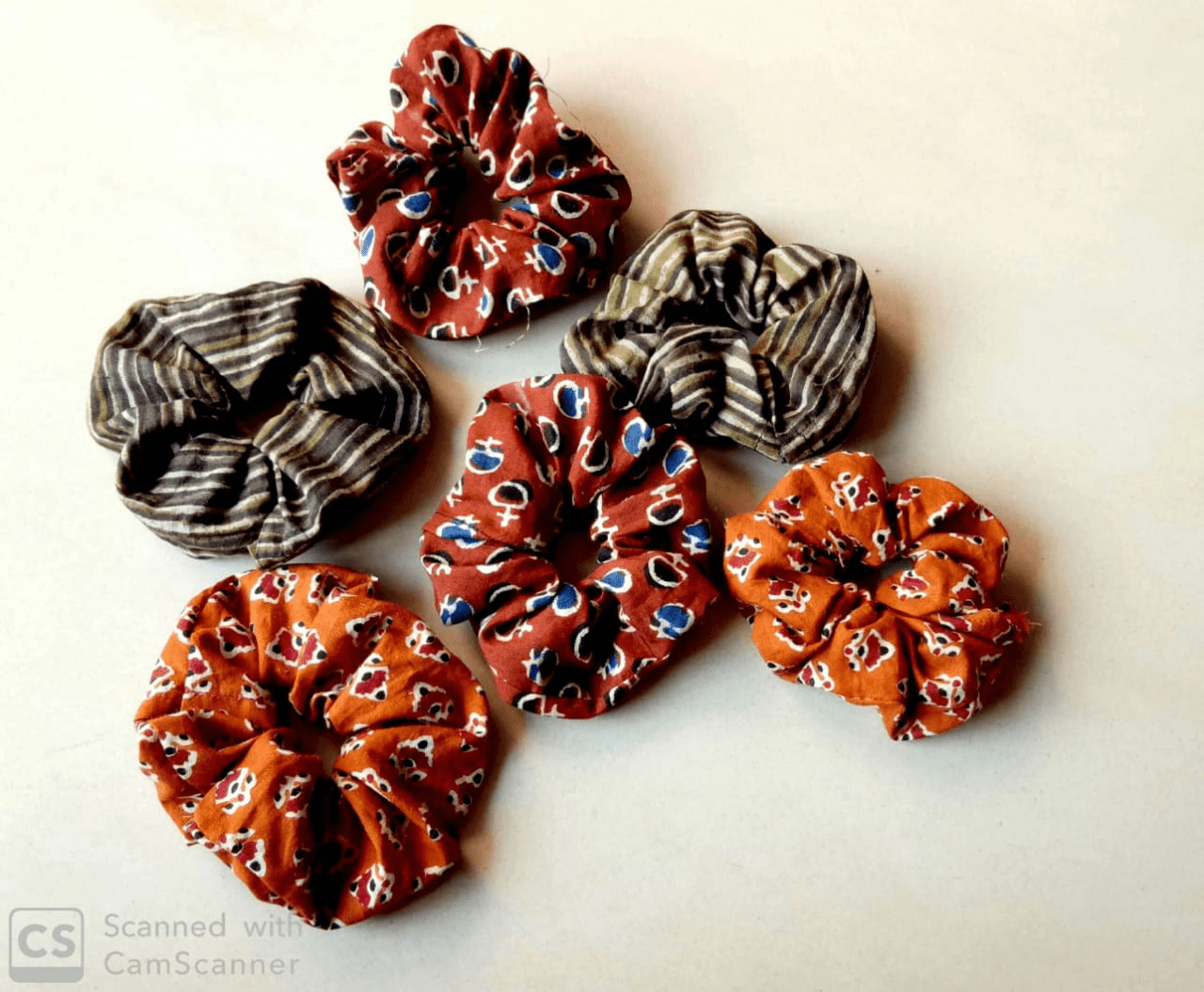
Conclusion
Craftsmen from all around the world are now embracing modern technologies to advance their profession. While modern equipment, methods, and synthetic dyes have supplanted ancient art forms, many Chippas have abandoned the craft of hand block printing. However, there are a few artists who devote their lives to the ancient and distinct skill of dyeing and printing. We must embrace and value this textile to save it from dwindling due to the influence of fast fashion and western clothing on Indian clothing culture.
Reference
- Raj S & Choudhuri P K, National Workshop and Seminar on “Vegetable dye and its application on textiles”, SilpaSadana, VisvaBharati, December 2011, March 2007, pp 24-28.
- Bora K, Are you an Indian traditional block prints lover? Here’s all you need to know, 2020. yehaindia.com
Authors:
Kshipra Gadey
Sayali Gaikwad
Guide: Dr. Anshu Sharma
PG Department of Textile Science and Apparel Design
SNDT Women’s University, Juhu, Mumbai

